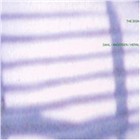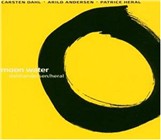Home » Jazz Articles » Multiple Reviews » Carsten Dahl/Arild Andersen/Patrice Heral: The Sign & Moon Water
Carsten Dahl/Arild Andersen/Patrice Heral: The Sign & Moon Water
Both discs are defined by the trio
But the foundation on which all these performers base their sound manipulations is improvisation. Some may be more structured than others, but the idea of sampling sounds performed in the moment and feeding them back to help push a group's exploration in new directions is giving artists an unprecedented freedom. Some may use it more overtly than others, but in all cases it allows smaller ensembles to create bigger sounds. And while some may use this recent development as a foundation on which their work revolves, as is the case with Parker's Electro-Acoustic Ensemble, others just consider it one more "instrument at their disposal.
Such is the case with Danish pianist Carsten Dahl's trio with Norwegian bassist Arild Andersen and French percussionist Patrice Heral. The trio came together in '02, through Dahl's impetus and that of his record company, Stunt. Andersen and Heral are, of course, no strangers to each other, having recorded Karta for ECM at the turn of the century with trumpeter Marcus Stockhausen and guitarist Terje Rypdal, another album that took advantage of the various electronic manipulations available. They have continued to work together in other contexts, most notably again with Stockhausen, but this time utilizing acoustic guitarist Ferenc Snetberger on the '04 ENJA release Joyosa.
But the link that ties all of Andersen and Heral's projects together is an openness, a lack of fear to placing themselves in situations without a safety net. Joyosa found them in a more structured environment, with all the material based on preconceived compositions. Karta, on the other hand, was another beast entirely. While four of the eleven tracks were composed contributions by Stockhausen and Andersen, the bulk of the release came from a single 90-minute improvised piece that was later edited down into seven self-contained pieces.
Dahl, a remarkable self-taught pianist who began life as a drummer, has been gaining greater recognition as an improviser and composer since he emerged on the scene in the late '90s. For this project he was clearly looking for artists who could combine imaginative interpretation of preconceived form and and the ability to create spontaneous compositions in the moment. And so the trio of Dahl, Andersen and Heral came together, first for a tour that demonstrated an immediate chemistry, and then for the first of two recordings — '02's The Sign. The trio would continue to work together, recording a second CD, '04's Moon Water. Both discs are defined by the trio's fearless approach to free improvisation that is about creating form instantaneously; the inclusion of electronics and live sampling to augment the trio's sound; and open interpretation of compelling compositions by Dahl and Andersen.
 Dahl/Andersen/Heral
Dahl/Andersen/Heral
The Sign
Stunt Records STUCD 02032
2002
That nearly a third of the material on their debut, The Sign, is completely free improvisation, demonstrates the kind of simpatico that emerged during the trio's first tour. That it is sometimes difficult to differentiate the improvisations from the composed material — mostly by Dahl, but with one composition by Andersen — makes the trio's open-ended approach all the more remarkable.
While the trio explores a range of dynamics, the ambience on The Sign is one of space, texture and subtlety. On the collaborative piece "The 9th Day, Andersen creates a wash of bowed bass that is a subtle underpinning for his and Dahl's darker, more impressionistic overlays. Heral, combining kit work with a variety of hand percussion, adds colour rather than rhythmic thrust. He also contributes vocals that range from a gentle falsetto to a bass voice reminiscent of throat singing.
The trio is less about individual soloing, and more about a collective approach that finds everyone on equal footing. Dahl's "Escapes begins with an abstract rubato passage that demonstrates how the trio, even with specific direction, are able to inject an element of freedom into the mix. The piece ultimately resolves into more identifiable form, with Heral playing more the rhythmist over a pedal tone vamp that gives both Andersen and Heral plenty of space, both rhythmically and harmonically. Dahl's debt to Keith Jarrett is clear.
"The Sorrow of Mankind, another Dahl composition, is suitably stark and spacious, with Dahl's playing delicate and spare. Andersen's characteristically warm and full sound and Heral's gentle percussion are in perfect accord with Dahl, building the piece from near silence to a more lyrical dramatic centre. "On Hyperborean, originally recorded on his own recording of the same name, Andersen substitutes real-time looping of arco bass, across the range of the instrument, for the string quartet that was on the original recording, and to great effect. The first three minutes are, in fact, Andersen on his own, layering fluttering pizzicato lines over the ambient backwash, with Dahl and Andersen finally entering and giving the piece more form.
The Sign has little to do with the American jazz tradition, being rooted, instead, in a more European impressionism. There's clearer precedence in the generally austere ECM approach than there is in anything that remotely resembles, for example, swing. Still, the collaborative "Crawl Before You Walk centres on a gentle walking pulse that belies a greater understanding of the American tradition, albeit radically transformed and placed in a generally more ethereal context.
 Dahl/Andersen/Heral
Dahl/Andersen/Heral
Moon Water
Stunt Records STUCD 03132
2004
Recorded a year after The Sign, Moon Water shows definite signs of growth and increased interplay. Once again spontaneous composition makes up a third of the disc, with Dahl contributing six compositions and Andersen two.
There's an even stronger sense of immediate form emergent in the group improvisations, most notably on "Eouter et Jouer I which, at over 15 minutes, is the centrepiece of the album. Starting from near silence, with Andersen delivering round, in-the-gut low tones and Heral adding subtle textures, Dahl enters gradually. Anderson and Dahl are especially in synch, both building figures that are sometimes in response to the other's ideas, at other times moving things forward. Heral slowly introduces a slow 4/4 pulse and the whole piece takes on form little-by-little. Lengthy improvisations such as this can often appear aimless, meandering; but while Dahl, Andersen and Heral are clearly on the lookout, there is an underlying sense of purpose.
While the general mood is, like The Sign, impressionistic and contemplative, there are moments of brighter expression. Dahl's up-tempo "Egyptionary is based on a simple 7/4 motif, but in the hands of Andersen the ostinato doesn't remain static for long. Dahl's solo is surprisingly aggressive, pounding out close clusters of notes in a Cecil Taylor-like fashion. But eventually the piece returns to the ostinato, this time with Andersen and Dahl holding it down in order to give Heral the most overt drum solo of the set.
The short improvised piece "Rush Brush, once again, demonstrates Dahl's roots in Jarrett, this time with the kind of open-endedness that was such a large part of Jarrett's work with his American Quartet. This may be free improvisation, but there's a clear concept, with Dahl book-ending the more adventurous middle section with a consistent, albeit idiosyncratic theme on both sides.
Like "Crawl Before You Walk on The Sign, the aptly-titled "After Crawl is based around Andersen's fast walk and Heral's pulsing cymbal work, albeit more assertive and up-tempo this time around. Still, like "Crawl Before You Walk, it demonstrates that the trio is not all about lyrical impressionism and has some basis in more conventional jazz tradition.
There is also a stronger allegiance to song form on Moon Water. "Hymne and "Disembodied, both Dahl compositions, have elegantly-stated themes, although on the latter it's Andersen who is the primary voice. "Joy could easily come from Jarrett's '70s European Quartet songbook, again adhering more to strict form and delineated solos. Andersen's "The Day closes the album off on a gentle note, again with a stronger disposition to structure.
But as much as Moon Water has a clearer definition, and is generally less abstract than its predecessor, it merely demonstrates another side to the trio that is, in fact, wholly consistent. The lyricism of The Sign is taken to further extremes, while the free play becomes even more unfettered yet pointed. Based on Arild Andersen's website, this trio is still a going concern, so hopefully there will be future recordings with which to benchmark the trio's development.
Visit Carsten Dahl and Arild Andersen on the web.
The Sign
Personnel: Carsten Dahl (piano, vibraphone, marimba); Arild Andersen (double-bass, effects); Patrice Heral (drums, percussion, vocals, live electronics)
Track Listing: Le Triangle et Les Trois Allumettes; The Sorrow of Mankind; East of Lez; Hyperborean; The 9th Day; Escapes; The Sign; Crawl Before You Walk; Postludum
Moon Water
Personnel: Carsten Dahl (piano, percussion, boomerang sampler); Arild Andersen (double-bass, effects); Patrice Heral (drums, percussion, voice, live electronics)
Track Listing: Ecouter et Jouer II; Egyptionary; Passing Thought; One Song; Rush Brush; Hymne; Eouter et Jouer I; Disembodied; After Crawl; Moon Water; Joy; The Day
< Previous
Brian Eno: The Soundtracks Reissues
Comments
Tags
For the Love of Jazz
 All About Jazz has been a pillar of jazz since 1995, championing it as an art form and, more importantly, supporting the musicians who create it. Our enduring commitment has made "AAJ" one of the most culturally important websites of its kind, read by hundreds of thousands of fans, musicians and industry figures every month.
All About Jazz has been a pillar of jazz since 1995, championing it as an art form and, more importantly, supporting the musicians who create it. Our enduring commitment has made "AAJ" one of the most culturally important websites of its kind, read by hundreds of thousands of fans, musicians and industry figures every month.

















